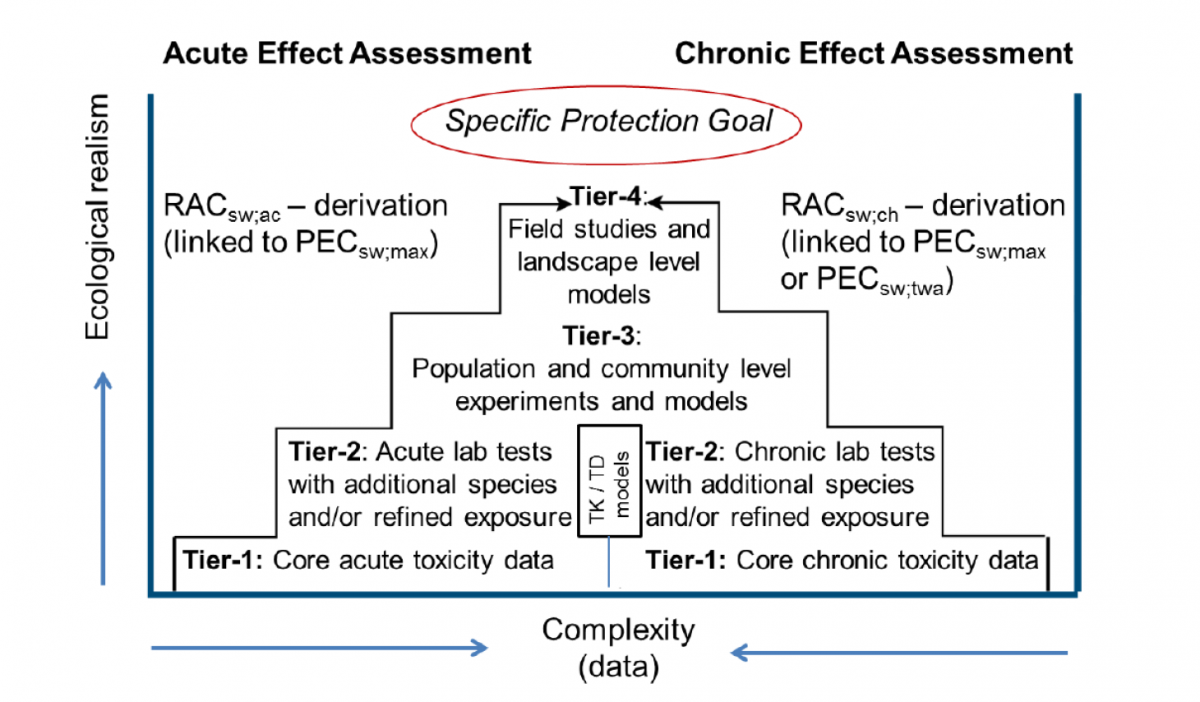- Your Product Type
- Your Study Type
- Aquatic Ecotoxicology
- Aquatic Invertebrates
- OECD 202: Daphnia sp., Acute Immobilisation Test
- OECD 211: Daphnia magna Reproduction Test
- OECD 235: Chironomus sp., Acute Immobilisation Test
- OECD 218/219: Sediment-Water Chironomid Toxicity Test Using Spiked Sediment/Spiked Water
- OECD 233: Sediment-Water Chironomid Life-Cycle Toxicity Test Using Spiked Water or Spiked Sediment
- OECD 225: Sediment-water Lumbriculus Toxicity Test Using Spiked Sediment
- OECD 242: Potamopyrgus antipodarum Reproduction Test
- OECD 243: Lymnaea stagnalis Reproduction Test
- Fish and other vertebrates
- OECD 203: Fish, Acute Toxicity Test
- OECD 215: Fish Juvenile Growth Study
- OECD 212: Fish, Short-term Toxicity Test on Embryo and Sac-fry Stages
- OECD 231: The Amphibian Metamorphosis Assay
- OECD 236: Fish Embryo Acute Toxicity Test
- OECD 210: Fish, Early-life Stage Toxicity Test
- OECD 229 Fish Short Term Reproduction Assay and OECD 230 21-day Fish Assay
- OECD 240 Medaka Extended One Generation Reproduction Test (MEOGRT)
- OECD 248: Xenopus Eleutheroembryonic Thyroid Assay
- OPPTS 850.1500: Fish Life Cycle Toxicity Test
- OÈCD 234 Fish sexual development test
- Aquatic plants
- Analytical Dose Verification
- Aquatic Invertebrates
- Chemistry
- Biodegradation Studies
- Analytical Chemistry Studies and Residues
- Physical-Chemical Properties Studies
- Storage Stability Studies
- OPPTS 830.6302, OPPTS 830.6303,and OPPTS 830.6304: Physical State, Colour and Odor at 20 °C and at 101.3 kPa
- EU A.1: Melting temperature/range
- EU A.2: Boiling temperature
- EU A.3: Relative density (liquids and solids)
- EU A.4: Vapour pressure
- EU A.5: Surface tension
- EU A.9: Flashpoint
- EU A.10: Flammability (solids)
- EU A.12: Flammability (contact with water)
- EU A.13: Pyrophoric properties of solids and liquids
- EU A.16: Relative self-ignition temperature for solids
- EU A.17: Oxidising properties
- OECD 114: Viscosity of Liquids
- Environmental Fate
- Transformation in Soil
- Transformation in Water
- Transformation in Manure
- Adsorption on Soil and Sewage Sludge
- Bioaccumulation and Bioconcentration
- Terrestrial Ecotoxicology
- Non-target Arthropods
- Non-target arthropod testing with the parasitic wasp (Aphidius rhopalosiphi)
- Non-target arthropod testing with the lacewing (Chrysoperla carnea)
- Non-target arthropod testing with the ladybird beetle (Coccinella septempunctata)
- Non-target arthropod testing with the predatory bug (Orius laevigatus)
- Non-target arthropod testing with the predatory mite (Typhlodromus pyri)
- Non-target arthropod testing with the rove beetle (Aleochara bilineata)
- Non-target arthropod testing with the carabid beetle (Poecilus cupreus)
- Non-target arthropod testing with the wolf spider (Pardosa spec.)
- Soil Organisms
- Honey Bees and other Pollinators
- OECD 213/214: Honey bees, Acute Oral and Acute Contact Toxicity Test
- OECD 245: Honey Bee (Apis Mellifera L.), Chronic Oral Toxicity Test (10-Day Feeding)
- OECD 237: Honey Bee Larval Toxicity Test, Single Exposure
- OECD 239: Honey Bee Larval Toxicity Test
- EPPO 170: Honey Bee Field Study – do plant protection products effect honey bee colonies?
- Oomen et al. 1992: Honey Bee Brood Feeding Study
- OECD 75: Honey Bee Brood Test under Semi-field Conditions in Tunnels
- OECD 246/247 Acute Oral and Contact Toxicity to the Bumblebee, Bombus terrestris L.
- Solitary Bee Acute Contact Toxicity Study in the Laboratory (Osmia sp.) Solitary Bee Acute Oral Toxicity Study in the Laboratory (Osmia sp.) (protocols for ringtests with solitary bees recommended by the non-Apis working group)
- SANTE/11956/2016 rev.9 Residue trials for MRL setting in honey
- Non-target plants
- OECD 208: Terrestrial Plant Test - Seedling Emergence and Seedling Growth Test
- OECD 227: Terrestrial Plant Test - Vegetative Vigour Test
- OCSPP 850.4100: Seedling Emergence and Seedling Growth
- OCSPP 850.4150: Vegetative Vigor
- EPPO PP 1/207(2): Efficacy evaluation of plant protection products, Effects on succeeding crops
- Field Studies
- Non-target Arthropods
- Ecological Modelling
- Quality Assurance
- Testing of Potential Endocrine Disruptors
- Aquatic Ecotoxicology
- News
- Company
- Career
- Contact
Ecological Modelling
Enhancing experimental data for the Environmental Risk Assessment
ibacon supports chemical industries since 1994 with efficient experimental labortory and field studies for the environmental risk assessment of their products. Experience shows that experimental data cannot answer all questions risk assessors have. Often, further experiments may be too laborious, too time-consuming or even technically unfeasible. This is where Ecological Modelling can help.
Please find our latest flyer for download at the bottom of the page.

Based on the results of laboratory and field studies, Ecological Modelling can help understand the mechanisms underlying the observed effects and to answer questions like these:
- Most susceptible stage: Which life stage or developmental phase of an organism is most susceptible to an exposure?
- Recovery potential: Can recovery be expected after an initial effect on populations of non-target organisms? How much time will a population need to recover?
- Extrapolations to different exposure scenarios or different environmental conditions: If experimental data exist for certain exposure conditions, specific environmental conditions or a certain experimental region, what can we expect under different exposure conditions, in other regions or at changed environmental conditions?
- Long-term effects: How will an impact discovered in laboratory experiments influence population development in the real world?

EFSA: Experiments and models support the environmental risk assessment: Tier 1 and tier 2 effect assessments are based on single-species laboratory toxicity tests, but tier 2 assessment may be complemented with TK-TD models. Tier 3 and tier 4 may concern a combination of experimental data and modelling to assess population and/or community level responses (e.g. recovery, indirect effects) at relevant spatio-temporal scales.
(EFSA, 2014)
ibacon's modelling portfolio
Please find below some examples of our ecological modelling portfolio. We will be happy to explain to you more details fitted to your needs.
- For survival data, we offer analysis with the Generalized Unified Threshold model of Survival (GUTS)
- For the analysis of sublethal effects, we provide analysis with DEBtox models
- For Toxicokinetic – toxicodynamic (TKTD) modelling on population level, we offer analysis and predictions with DEB-IBM
- For the Honey Bee population level, we are working on the application of BEEHAVE (Becher et al, 2014)
Ecological modelling is a highly dynamic field, and we are actively taking part in the development of models and quality assessment of modelling results. Most important to us is compliance of our work with good modelling practice according to EFSA (2014).
For your products, we are happy to discuss with you how model applications may support the environmental risk assessment. Contact us about any ecological modelling you are interested in, we will find a solution for you!
Literature
- EFSA Panel on Plant Protection Products and their Residues (2014). Scientific Opinion on good modelling practice in the context of mechanistic effect models for risk assessment of plant protection products. EFSA Journal. 12(3), 3589, 92 pp.
- Zimmer EI, Jager T, Ducrot V, Lagadic L, Kooijman SALM (2012). Juvenile food limitation in standardized tests - a warning to ecotoxicologists. Ecotoxicology. 21(8), 2195-2204
- Jager T, Zimmer EI (2012). Simplified dynamic energy budget model for analysing ecotoxicity data. Ecological Modelling. 225, 74-81
- Jager T, Martin BT, Zimmer EI (2013). DEBkiss or the quest for the simplest generic model of animal life history. Journal of Theoretical Biology. 328, 9-18.
- Martin BT, Zimmer EI, Grimm V & Jager T (2012). Dynamic Energy Budget theory meets individual-based modelling: a generic and accessible implementation. Methods in Ecology and Evolution. 3, 445-449
- Becher MA, Grimm V, Thorbek P, Horn J, Kennedy PJ, Osborne JL (2014). BEEHAVE: a systems model of honeybee colony dynamics and foraging to explore multifactorial causes of colony failure. Journal of Applied Ecology. 51, 470-482
Downloads:
| Attachment | Size |
|---|---|
| 677.24 KB |
